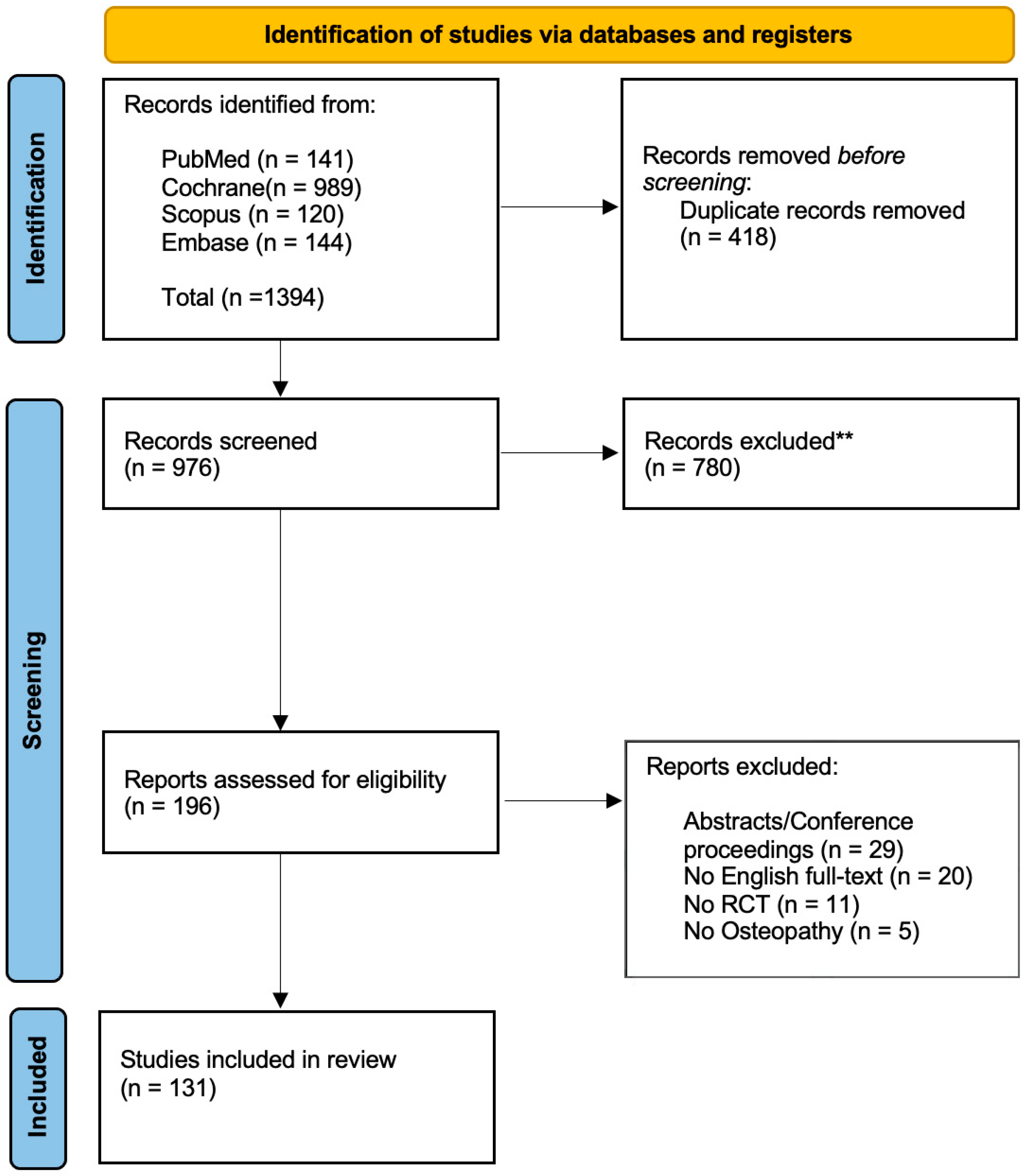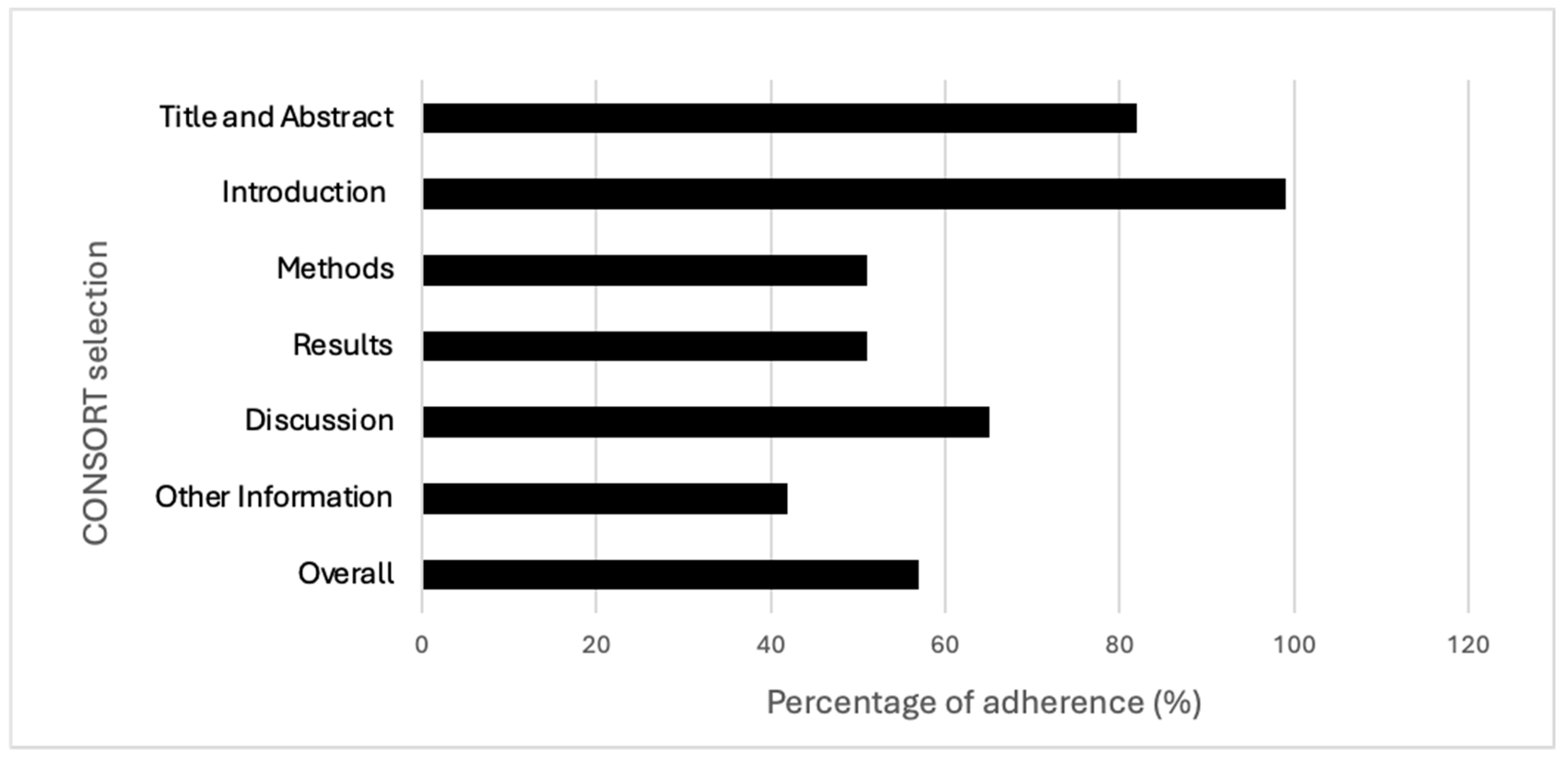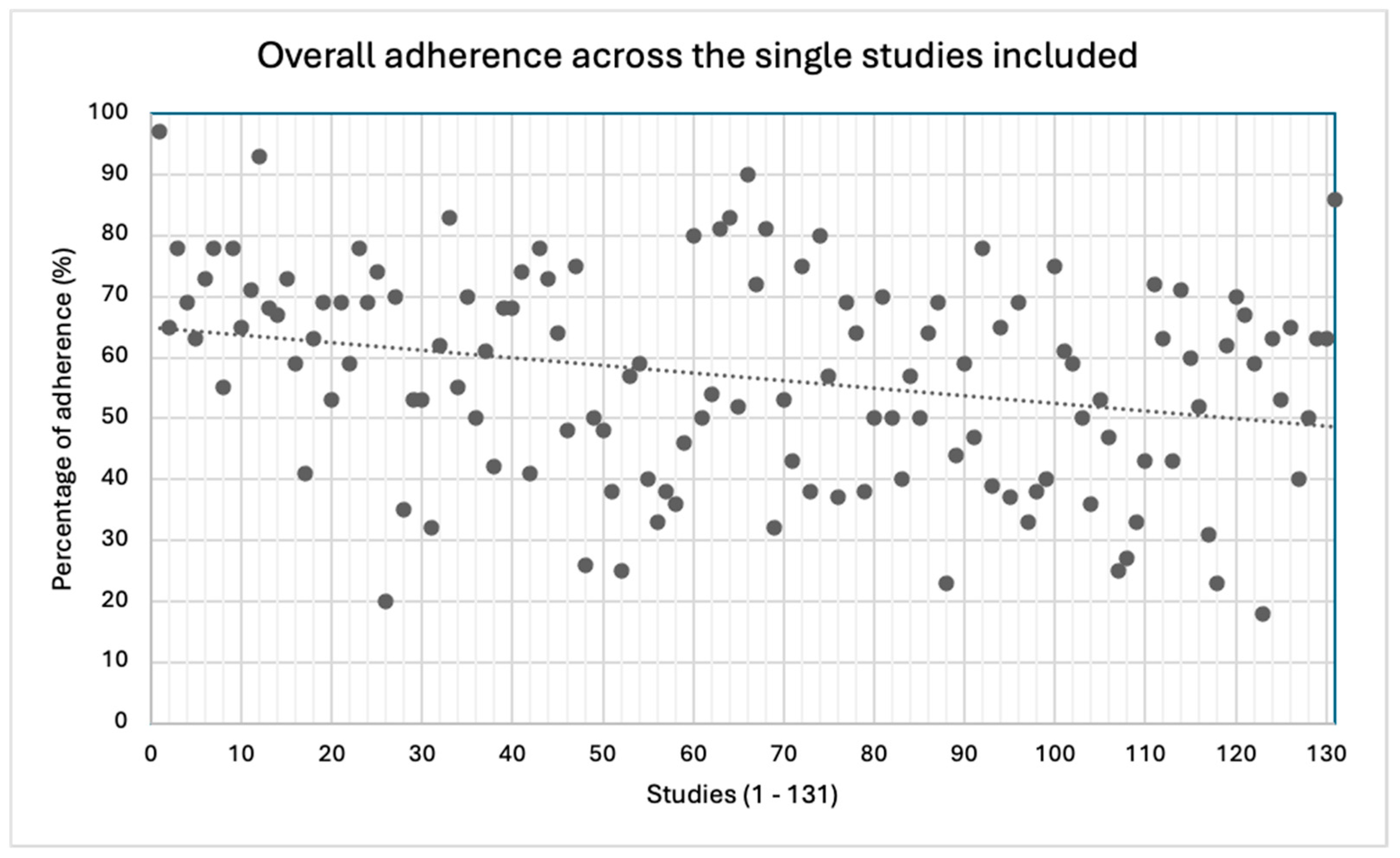A Critical Appraisal of Reporting in Randomized Controlled Trials Investigating Osteopathic Manipulative Treatment: A Meta-Research Study
Abstract
:1. Introduction
2. Materials and Methods
2.1. Eligibility
2.2. Study Selection
2.3. Data Collection Process
2.4. Evaluating the Completeness of Reporting
2.5. Evaluating the Risk of Bias
2.6. Statistical Analysis
3. Results
3.1. Adherence to CONSORT Checklist (Completeness of Reporting)
3.2. Relationship between Completeness of Reporting and Risk of Bias
3.3. Relationship between Completeness of Reporting and Protocol Registration, Journals Characteristics and Date of Publication
4. Discussion
4.1. Summary of Results
4.2. Implications for Future Research
4.3. Limitations
5. Conclusions
Supplementary Materials
Author Contributions
Funding
Data Availability Statement
Conflicts of Interest
References
- Available online: https://oialliance.org/wp-content/uploads/2024/02/OIA_Report_2020_FINAL_Summary.pdf (accessed on 1 June 2024).
- Available online: https://www.who.int/publications/i/item/9789241599665 (accessed on 1 June 2024).
- Morin, C.; Gaboury, I. Osteopathic empirical research: A bibliometric analysis from 1966 to 2018. BMC Complement Med. Ther. 2021, 21, 196. [Google Scholar] [CrossRef] [PubMed]
- Dal Farra, F.; Aquino, A.; Tarantino, A.G.; Origo, D. Effectiveness of Myofascial Manual Therapies in Chronic Pelvic Pain Syndrome: A Systematic Review and Meta-Analysis. Int. Urogynecol. J. 2022, 33, 2963–2976. [Google Scholar] [CrossRef]
- Buffone, F.; Monacis, D.; Tarantino, A.G.; Dal Farra, F.; Bergna, A.; Agosti, M.; Vismara, L. Osteopathic Treatment for Gastrointestinal Disorders in Term and Preterm Infants: A Systematic Review and Meta-Analysis. Healthcare 2022, 10, 1525. [Google Scholar] [CrossRef] [PubMed]
- Dal Farra, F.; Buffone, F.; Risio, R.G.; Tarantino, A.G.; Vismara, L.; Bergna, A. Effectiveness of osteopathic interventions in patients with non-specific neck pain: A systematic review and meta-analysis. Complement Ther. Clin. Pract. 2022, 49, 101655. [Google Scholar] [CrossRef]
- Cerritelli, F.; Ruffini, N.; Lacorte, E.; Vanacore, N. Osteopathic manipulative treatment in neurological diseases: Systematic review of the literature. J. Neurol. Sci. 2016, 369, 333–341. [Google Scholar] [CrossRef]
- Bucher, H.C.; Guyatt, G.H.; Cook, D.J.; Holbrook, A.; McAlister, F.A. Users’ guides to the medical literature: XIX. Applying clinical trial results. A. How to use an article measuring the effect of an intervention on surrogate end points. Evidence-Based Medicine Working Group. JAMA 1999, 282, 771–778. [Google Scholar] [CrossRef] [PubMed]
- Moher, D.; Schulz, K.F.; Altman, D.G. The CONSORT statement: Revised recommendations for improving the quality of reports of parallel-group randomised trials. Lancet 2001, 357, 1191–1194. [Google Scholar] [CrossRef]
- Cochrane. Cochrane Handbook for Systematic Reviews of Interventions, Version 6.4; Higgins, J.P.T., Thomas, J., Chandler, J., Cumpston, M., Li, T., Page, M.J., Welch, V.A., Eds.; (Updated August 2023); The Cochrane Collaboration: London, UK; John Wiley & Sons Ltd.: Hoboken, NJ, USA, 2023. [Google Scholar]
- Innocenti, T.; Salvioli, S.; Giagio, S.; Feller, D.; Cartabellotta, N.; Chiarotto, A. Declaration of use and appropriate use of reporting guidelines in high-impact rehabilitation journals is limited: A meta-research study. J. Clin. Epidemiol. 2021, 131, 43–50. [Google Scholar] [CrossRef]
- Ioannidis, J.P.A. Meta-research: Why research on research matters. PLoS Biol. 2018, 16, e2005468. [Google Scholar] [CrossRef]
- Ioannidis, J.P.; Fanelli, D.; Dunne, D.D.; Goodman, S.N. Meta-research: Evaluation and Improvement of Research Methods and Practices. PLoS Biol. 2015, 13, e1002264. [Google Scholar] [CrossRef]
- Higgins, J.P.; Altman, D.G.; Gøtzsche, P.C.; Jüni, P.; Moher, D.; Oxman, A.D.; Savović, J.; Schulz, K.F.; Weeks, L.; Sterne, J.A.C.; et al. The Cochrane Collaboration’s tool for assessing risk of bias in randomised trials. BMJ 2011, 343, d5928. [Google Scholar] [CrossRef] [PubMed]
- Butcher, N.J.; Monsour, A.; Mew, E.J.; Chan, A.-W.; Moher, D.; Mayo-Wilson, E.; Terwee, C.B.; Chee-A-Tow, A.; Baba, A.; Gavin, F.; et al. Guidelines for Reporting Outcomes in Trial Reports: The CONSORT-Outcomes 2022 Extension. JAMA 2022, 328, 2252–2264. [Google Scholar] [CrossRef] [PubMed]
- Innocenti, T.; Giagio, S.; Salvioli, S.; Feller, D.; Minnucci, S.; Brindisino, F.; IJzelenberg, W.; Ostelo, R.; Chiarotto, A. Completeness of Reporting Is Suboptimal in Randomized Controlled Trials Published in Rehabilitation Journals, with Trials with Low Risk of Bias Displaying Better Reporting: A Meta-research Study. Arch. Phys. Med. Rehabil. 2022, 103, 1839–1847. [Google Scholar] [CrossRef]
- Page, M.J.; McKenzie, J.E.; Bossuyt, P.M.; Boutron, I.; Hoffmann, T.C.; Mulrow, C.D.; Shamseer, L.; Tetzlaff, J.M.; Akl, E.A.; Brennan, S.E.; et al. The PRISMA 2020 statement: An updated guideline for reporting systematic reviews. BMJ 2021, 372, n71. [Google Scholar] [CrossRef] [PubMed]
- Ouzzani, M.; Hammady, H.; Fedorowicz, Z.; Elmagarmid, A. Rayyan-a web and mobile app for systematic reviews. Syst. Rev. 2016, 5, 210. [Google Scholar] [CrossRef]
- Flemyng, E.; Moore, T.H.; Boutron, I.; Higgins, J.P.T.; Hróbjartsson, A.; Nejstgaard, C.H.; Dwan, C. Using Risk of Bias 2 to assess results from randomised controlled trials: Guidance from Cochrane. BMJ Evid. Based Med. 2023, 28, 260–266. [Google Scholar] [CrossRef]
- Lehane, E.; Leahy-Warren, P.; O'Riordan, C.; Savage, E.; Drennan, J.; O’Tuathaigh, C.; O’Connor, M.; Corrigan, M.; Burke, F.; Hayes, M. Evidence-based practice education for healthcare professions: An expert view. BMJ Evid. Based Med. 2019, 24, 103–108. [Google Scholar] [CrossRef]
- Thomas, E.T.; Heneghan, C. Catalogue of bias: Selective outcome reporting bias. BMJ Evid. Based Med. 2022, 27, 370–372. [Google Scholar] [CrossRef]
- Riley, S.P.; Swanson, B.T.; Cook, C.E. “Trustworthiness”, confidence in estimated effects, and confidently translating research into clinical practice. Arch. Physiother. 2023, 13, 8. [Google Scholar] [CrossRef] [PubMed]
- Murad, M.H.; Katabi, A.; Benkhadra, R.; Montori, V.M. External validity, generalisability, applicability and directness: A brief primer. BMJ Evid. Based Med. 2018, 23, 17–19. [Google Scholar] [CrossRef]
- De Angelis, C.; Drazen, J.M.; Frizelle, F.A.; Haug, C.; Hoey, J.; Horton, R.; Kotzin, S.; Laine, C.; Marusic, A.; Overbeke, J.P.M.; et al. Clinical trial registration: A statement from the International Committee of Medical Journal Editors. N. Engl. J. Med. 2004, 351, 1250–1251. [Google Scholar] [CrossRef]
- Lindsley, K.; Fusco, N.; Teeuw, H.; Mooij, E.; Scholten, R.; Hooft, L. Poor compliance of clinical trial registration among trials included in systematic reviews: A cohort study. J. Clin. Epidemiol. 2021, 132, 79–87. [Google Scholar] [CrossRef]
- Viergever, R.F.; Li, K. Trends in global clinical trial registration: An analysis of numbers of registered clinical trials in different parts of the world from 2004 to 2013. BMJ Open. 2015, 5, e008932. [Google Scholar] [CrossRef] [PubMed]
- Leech, J.B.; Owen, W.E.; Young, J.L.; Rhon, D.I. Incomplete reporting of manual therapy interventions and a lack of clinician and setting diversity in clinical trials for neck pain limits replication and real-world translation. A scoping review. J. Man. Manip. Ther. 2023, 31, 153–161, Erratum in J. Man. Manip. Ther. 2023, 31, 214. [Google Scholar] [CrossRef] [PubMed]
- Alvarez, G.; Solà, I.; Sitjà-Rabert, M.; Fort-Vanmeerhaeghe, A.; Gich, I.; Fernándezd, C.; Urrútia, G. A methodological review revealed that reporting of trials in manual therapy has not improved over time. J. Clin. Epidemiol. 2020, 121, 32–44. [Google Scholar] [CrossRef]
- Gonzalez, G.Z.; Moseley, A.M.; Maher, C.G.; Nascimento, D.P.; Costa, L.D.C.M.; Costa, L.O. Methodologic Quality and Statistical Reporting of Physical Therapy Randomized Controlled Trials Relevant to Musculoskeletal Conditions. Arch. Phys. Med. Rehabil. 2018, 99, 129–136. [Google Scholar] [CrossRef] [PubMed]
- Gianola, S.; Castellini, G.; Agostini, M.; Bolotta, R.; Corbetta, D.; Frigerio, P.; Gasparini, M.; Gozzer, P.; Guariento, E.; Li, L.C.; et al. Reporting of Rehabilitation Intervention for Low Back Pain in Randomized Controlled Trials: Is the Treatment Fully Replicable? Spine 2016, 41, 412–418. [Google Scholar] [CrossRef]
- Candy, B.; Vickerstaff, V.; Jones, L.; King, M. Description of complex interventions: Analysis of changes in reporting in randomised trials since 2002. Trials 2018, 19, 110. [Google Scholar] [CrossRef]
- Dal Farra, F.; Risio, R.G.; Vismara, L.; Bergna, A. Effectiveness of osteopathic interventions in chronic non-specific low back pain: A systematic review and meta-analysis. Complement Ther Med. 2021, 56, 102616. [Google Scholar] [CrossRef]
- Hoffmann, T.C.; Glasziou, P.P.; Boutron, I.; Milne, R.; Perera, R.; Moher, D.; Altman, D.G.; Barbour, V.; Macdonald, H.; Johnston, M.; et al. Better reporting of interventions: Template for intervention description and replication (TIDieR) checklist and guide. BMJ 2014, 348, g1687. [Google Scholar] [CrossRef]
- Yamato, T.; Maher, C.; Saragiotto, B.; Moseley, A.; Hoffmann, T.; Elkins, M.; Brooks, D. The TIDieR Checklist Will Benefit the Physiotherapy Profession. Physiother. Can. 2016, 68, 311–314. [Google Scholar] [CrossRef] [PubMed]
- Alvarez, G.; Cerritelli, F.; Urrutia, G. Using the template for intervention description and replication (TIDieR) as a tool for improving the design and reporting of manual therapy interventions. Man. Ther. 2016, 24, 85–89. [Google Scholar] [CrossRef]
- Nascimento, D.P.; Gonzalez, G.Z.; Araujo, A.C.; Moseley, A.; Maher, C.; Costa, L.O.P. Factors associated with the reporting quality of low back pain systematic review abstracts in physical therapy: A methodological study. Braz. J. Phys. Ther. 2021, 25, 233–241. [Google Scholar] [CrossRef] [PubMed]
- Mrowinski, M.J.; Fronczak, P.; Fronczak, A.; Ausloos, M.; Nedic, O. Artificial intelligence in peer review: How can evolutionary computation support journal editors? PLoS ONE 2017, 12, e0184711. [Google Scholar] [CrossRef]
- Chubb, J.; Cowling, P.; Reed, D. Speeding up to keep up: Exploring the use of AI in the research process. AI Soc. 2022, 37, 1439–1457. [Google Scholar] [CrossRef] [PubMed]
- Liberati, A.; Altman, D.G.; Tetzlaff, J.; Mulrow, C.; Gøtzsche, P.C.; Ioannidis, J.P.A.; Clarke, M.; Devereaux, P.J.; Kleijnen, J.; Moher, D. The PRISMA statement for reporting systematic reviews and meta-analyses of studies that evaluate healthcare interventions: Explanation and elaboration. BMJ 2009, 339, b2700. [Google Scholar] [CrossRef] [PubMed]



| CONSORT Items | Studies Where Item Was Not Applicable (n) | Mean Adherence (%) Calculated in Studies Where Item Was Applicable | ||
|---|---|---|---|---|
| Title and Abstract | 1a | Identification as a randomised trial in the title | 0 | 65 |
| 1b | Structured summary of trial design, methods, results, and conclusions | 0 | 99 | |
| Introduction Background and objectives | 2a | Scientific background and explanation of rationale | 0 | 98 |
| 2b | Specific objectives or hypotheses | 0 | 100 | |
| Methods Trial design | 3a | Description of trial design including allocation ratio | 0 | 24 |
| 3b | Important changes to methods after trial commencement (such as eligibility criteria), with reasons | 128 | 67 | |
| Participants | 4a | Eligibility criteria for participants | 0 | 95 |
| 4b | Settings and locations where the data were collected | 0 | 50 | |
| Interventions | 5 | The interventions for each group with sufficient details to allow replication, including how and when they were actually administered | 0 | 79 |
| Outcomes | 6a | Completely defined prespecified primary and secondary outcome measures, including how and when they were assessed | 29 | 87 |
| 6b | Any changes to trial outcomes after the trial commenced, with reasons | 129 | 50 | |
| Sample size | 7a | How sample size was determined | 29 | 57 |
| 7b | When applicable, explanation of any interim analyses and stopping guidelines | 127 | 100 | |
| Sequence generation | 8a | Method used to generate the random allocation sequence | 0 | 73 |
| 8b | Type of randomization; details of any restriction (such as blocking and block size) | 0 | 30 | |
| Allocation concealment | 9 | Mechanism used to implement the random allocation sequence, describing any steps taken to conceal the sequence until interventions were assigned | 0 | 18 |
| Implementation | 10 | Who generated the random allocation sequence, who enrolled participants, and who assigned participants to interventions | 0 | 10 |
| Blinding | 11a | If performed, who was blinded after assignment to interventions and how | 27 | 74 |
| 11b | If relevant, description of the similarity of interventions | 64 | 55 | |
| Statistical methods | 12a | Statistical methods used to compare groups for primary and secondary outcomes | 0 | 24 |
| 12b | Methods for additional analyses, such as subgroup analyses and adjusted analyses | 115 | 69 | |
| Results Participant flow | 13a | For each group, the numbers of participants who were randomly assigned, received intended treatment, and were analysed for the primary outcome | 0 | 69 |
| 13b | For each group, losses and exclusions after randomization, together with reasons | 45 | 53 | |
| Recruitment | 14a | Dates defining the periods of recruitment and follow-up | 0 | 40 |
| 14b | Why the trial ended or was stopped | 129 | 50 | |
| Baseline data | 15 | A table showing baseline demographic and clinical characteristics for each group | 0 | 79 |
| Numbers analysed | 16 | For each group, number of participants (denominator) included in each analysis and whether the analysis was by original assigned groups | 0 | 24 |
| Outcomes and estimation | 17a | For each primary and secondary outcome, results for each group, and the estimated effect size and its precision (such as 95% CI) | 0 | 40 |
| 17b | For binary outcomes, presentation of both absolute and relative effect sizes is recommended | 124 | 71 | |
| Ancillary analyses | 18 | Results of any other analyses performed, including subgroup analyses and adjusted analyses, distinguishing prespecified from exploratory | 116 | 73 |
| Harms | 19 | All important harms or unintended effects in each group | 0 | 47 |
| Discussion Limitations | 20 | Trial limitations, addressing sources of potential bias, imprecision, and, if relevant, multiplicity of analyses | 0 | 85 |
| Generalizability | 21 | Generalizability (external validity, applicability) of the trial findings | 0 | 21 |
| Interpretation | 22 | Interpretation consistent with results, balancing benefits and harms, and considering other relevant evidence | 0 | 91 |
| Other information Registration | 23 | Registration number and name of trial registry | 0 | 50 |
| Protocol | 24 | Where the full trial protocol can be accessed, if available | 0 | 4 |
| Funding | 25 | Sources of funding and other support (such as supply of drugs), role of funders | 0 | 73 |
| L | H | Diff | L | H | Diff | L | H | Diff | L | H | Diff | L | H | Diff | |
|---|---|---|---|---|---|---|---|---|---|---|---|---|---|---|---|
| Title and Abstract | 91.1 | 71.0 | −20.1 | 95.1 | 78.7 | −16.4 | 83.1 | 76.9 | −6.2 | 82.6 | 78.5 | −4.1 | 89.8 | 78.1 | −11.7 |
| Introduction | 98.0 | 100 | 2.0 | 98.3 | 98.9 | 0.6 | 98.6 | 100 | 1.4 | 98.3 | 100 | 1.7 | 98.3 | 100 | 1.7 |
| Methods | 63.8 | 35.9 | −27.9 | 64.6 | 50.7 | −13.9 | 51.4 | 43.4 | −8 | 53.0 | 43.0 | −10.0 | 60.8 | 51.1 | −9.7 |
| Results | 69.6 | 32.9 | −36.7 | 76.8 | 49.6 | −27.2 | 51.8 | 30.3 | −21.5 | 50.3 | 56.4 | 6.1 | 68.2 | 42.7 | −25.5 |
| Discussion | 70.0 | 59.1 | −10.9 | 79.1 | 62.5 | −16.6 | 65.5 | 61.0 | −4.5 | 66.9 | 56.7 | −10.2 | 70.7 | 61.9 | −8.8 |
| Other information | 53.7 | 31.2 | −22.5 | 51.1 | 42.8 | −8.3 | 42.3 | 43.1 | 0.8 | 43.4 | 37.7 | −5.7 | 62.1 | 49.5 | −12.6 |
| Overall adherence | 69.1 | 44.6 | −24.5 | 72.0 | 56.4 | −15.6 | 57.7 | 48.4 | −9.3 | 58.0 | 54.2 | −3.8 | 68.4 | 55.6 | −12.8 |
| Coefficients | ||||
|---|---|---|---|---|
| 95% CI | ||||
| Variables | Beta Unstandardized (β) | p | Lower | Upper |
| D1 | 12.368 * | <0.001 ** | 8.901 * | 15.835 * |
| D2 | 7.218 * | 0.001 ** | 2.848 * | 11.589 * |
| D3 | 4.007 * | 0.044 * | 0.117 * | 7.898 * |
| D4 | 0.798 | 0.650 | −2.671 | 4.266 |
| D5 | 10.836 * | <0.001 ** | 7.267 * | 14.405 * |
| Overall RoB | −9.494 | 0.001 | −15.15 | −3.838 |
| Coefficients | ||||
|---|---|---|---|---|
| 95% CI | ||||
| Variables | Beta Unstandardized (β) | p | Lower | Upper |
| Recent year of publication | 0.453 | 0.168 | −0.193 | 1.098 |
| Higher quartile | 5.416 * | <0.001 ** | 2.805 * | 8.026 * |
| Open Access publication | −5.649 * | 0.016 * | −10.231 * | −1.067 * |
| Preliminary protocol | 19.226 * | <0.001 ** | 14.452 * | 24.001 * |
Disclaimer/Publisher’s Note: The statements, opinions and data contained in all publications are solely those of the individual author(s) and contributor(s) and not of MDPI and/or the editor(s). MDPI and/or the editor(s) disclaim responsibility for any injury to people or property resulting from any ideas, methods, instructions or products referred to in the content. |
© 2024 by the authors. Licensee MDPI, Basel, Switzerland. This article is an open access article distributed under the terms and conditions of the Creative Commons Attribution (CC BY) license (https://creativecommons.org/licenses/by/4.0/).
Share and Cite
Zambonin Mazzoleni, G.; Bergna, A.; Buffone, F.; Sacchi, A.; Misseroni, S.; Tramontano, M.; Dal Farra, F. A Critical Appraisal of Reporting in Randomized Controlled Trials Investigating Osteopathic Manipulative Treatment: A Meta-Research Study. J. Clin. Med. 2024, 13, 5181. https://doi.org/10.3390/jcm13175181
Zambonin Mazzoleni G, Bergna A, Buffone F, Sacchi A, Misseroni S, Tramontano M, Dal Farra F. A Critical Appraisal of Reporting in Randomized Controlled Trials Investigating Osteopathic Manipulative Treatment: A Meta-Research Study. Journal of Clinical Medicine. 2024; 13(17):5181. https://doi.org/10.3390/jcm13175181
Chicago/Turabian StyleZambonin Mazzoleni, Gabriele, Andrea Bergna, Francesca Buffone, Andrea Sacchi, Serena Misseroni, Marco Tramontano, and Fulvio Dal Farra. 2024. "A Critical Appraisal of Reporting in Randomized Controlled Trials Investigating Osteopathic Manipulative Treatment: A Meta-Research Study" Journal of Clinical Medicine 13, no. 17: 5181. https://doi.org/10.3390/jcm13175181






